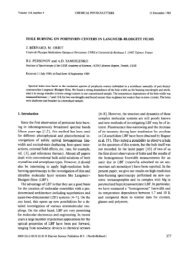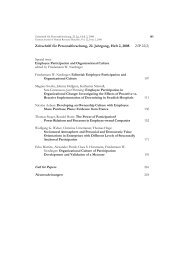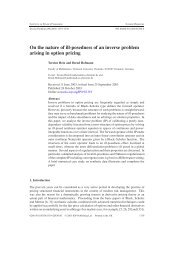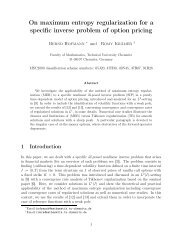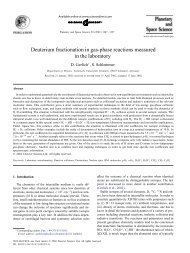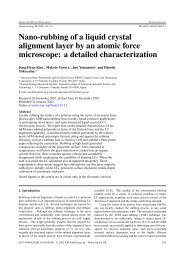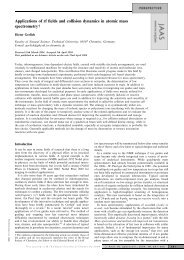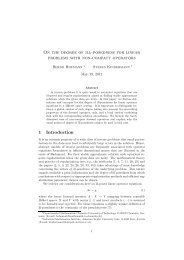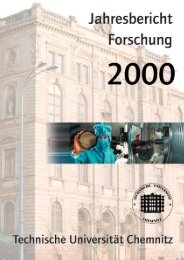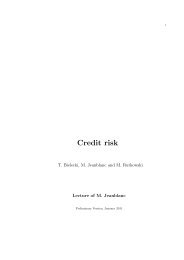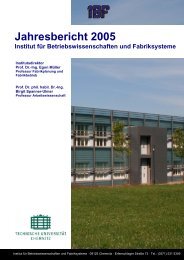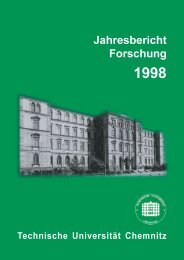Guided ion beam studies of electron and isotope transfer in N+N ...
Guided ion beam studies of electron and isotope transfer in N+N ...
Guided ion beam studies of electron and isotope transfer in N+N ...
Create successful ePaper yourself
Turn your PDF publications into a flip-book with our unique Google optimized e-Paper software.
JOURNAL OF CHEMICAL PHYSICS VOLUME 112, NUMBER 16 22 APRIL 2000<br />
<strong>Guided</strong> <strong>ion</strong> <strong>beam</strong> <strong>studies</strong> <strong>of</strong> <strong>electron</strong> <strong>and</strong> <strong>isotope</strong> <strong>transfer</strong><br />
<strong>in</strong> 14 N ¿ ¿ 15 N 2 collis<strong>ion</strong>s<br />
J. Glosik <strong>and</strong> A. Luca<br />
Department <strong>of</strong> Electronics <strong>and</strong> Vacuum Physics, Mathematics <strong>and</strong> Physics Faculty, Charles University,<br />
V Holesˇovičkách 2, Prague 8, Czech Republic<br />
S. Mark <strong>and</strong> D. Gerlich<br />
Institut für Physik, Technische Universität, 09107 Chemnitz, Germany<br />
�Received 27 October 1999; accepted 31 January 2000�<br />
Collis<strong>ion</strong>s <strong>of</strong> ground state N � <strong>ion</strong>s with N 2 were <strong>in</strong>vestigated <strong>in</strong> a <strong>Guided</strong> Ion Beam �GIB� apparatus<br />
at center-<strong>of</strong>-mass �CM� collis<strong>ion</strong> energies up to 10 eV. Isotopic label<strong>in</strong>g <strong>of</strong> the target gas, 15 N 2, was<br />
used as one criter<strong>ion</strong> to dist<strong>in</strong>guish <strong>electron</strong> <strong>transfer</strong>, atom <strong>transfer</strong>, <strong>and</strong> <strong>isotope</strong> exchange channels.<br />
The absolute cross sect<strong>ion</strong>s are <strong>in</strong> good agreement with previous measurements. By comb<strong>in</strong><strong>in</strong>g the<br />
GIB technique with time-<strong>of</strong>-flight analysis �acronym GIB-TOF� more detailed <strong>in</strong>format<strong>ion</strong> on the<br />
react<strong>ion</strong> dynamics has been obta<strong>in</strong>ed. The product velocity distribut<strong>ion</strong>s measured for 15 N 2 � <strong>and</strong><br />
14 N 15 N � <strong>in</strong>dicate that both, <strong>electron</strong> <strong>and</strong> atom <strong>transfer</strong>, have to be divided <strong>in</strong>to at least two parts, a<br />
direct one <strong>and</strong> one which seems to be characteristic for a long lived complex. The branch<strong>in</strong>g ratios<br />
derived for these four channels show a strong energy dependence. The mean product k<strong>in</strong>etic energy<br />
<strong>in</strong>dicates that the rema<strong>in</strong><strong>in</strong>g nitrogen atom is most probably formed <strong>in</strong> the metastable N( 2 D) state.<br />
For the nearly thermoneutral 14 N � – 15 N � <strong>isotope</strong> exchange it was observed that a significant fract<strong>ion</strong><br />
<strong>of</strong> the translat<strong>ion</strong>al energy is <strong>transfer</strong>red <strong>in</strong>to <strong>in</strong>ternal excitat<strong>ion</strong> <strong>of</strong> the neutral molecule. © 2000<br />
American Institute <strong>of</strong> Physics. �S0021-9606�00�00616-4�<br />
I. INTRODUCTION<br />
Despite its importance <strong>in</strong> model<strong>in</strong>g chemical processes<br />
<strong>in</strong> the earth <strong>ion</strong>osphere <strong>and</strong> planetary atmospheres, or for<br />
underst<strong>and</strong><strong>in</strong>g details <strong>of</strong> nitrogen discharges <strong>and</strong> plasmas,<br />
etc., the react<strong>ion</strong> <strong>of</strong> N � with N 2 has been the subject <strong>of</strong> only<br />
a few rather contradict<strong>in</strong>g experimental <strong>studies</strong> until 1991, as<br />
can be seen from the compilat<strong>ion</strong> by Phelps. 1 In order to use<br />
the 1.043 eV endothermic <strong>electron</strong> <strong>transfer</strong> react<strong>ion</strong><br />
N � �N 2→N 2 � �N as a reliable chemical thermometer �e.g.,<br />
<strong>in</strong> nonequilibrium <strong>ion</strong>/gas environments�, 2 it became necessary<br />
to measure reliable absolute cross sect<strong>ion</strong>s, especially <strong>in</strong><br />
the threshold reg<strong>ion</strong>. In 1993, the first GIB results were reported<br />
from the Freiburg mach<strong>in</strong>e. 3 These data have clearly<br />
shown that, for ground state <strong>ion</strong>s, the <strong>electron</strong> <strong>transfer</strong> cross<br />
sect<strong>ion</strong> is extremely small <strong>in</strong> the threshold reg<strong>ion</strong> �smaller<br />
than 0.005 Å 2 below 2 eV� <strong>and</strong> that it reaches its maximum<br />
<strong>of</strong> 2.5�0.5 Å 2 only at a collis<strong>ion</strong> energy <strong>of</strong> 8 eV. These<br />
results have been corroborated <strong>and</strong> extended us<strong>in</strong>g two other<br />
GIB mach<strong>in</strong>es, i.e., the Utah GIB mass spectrometer <strong>and</strong> the<br />
Trento GIB crossed <strong>beam</strong> experiment. 4 This publicat<strong>ion</strong><br />
which will be denoted paper I <strong>in</strong> the follow<strong>in</strong>g gives a summary<br />
<strong>of</strong> the situat<strong>ion</strong> until 1994 <strong>in</strong>clud<strong>in</strong>g a complete list <strong>of</strong><br />
references. More detailed results from the Freiburg/Chemnitz<br />
GIB apparatus have been reported <strong>in</strong> 1996. 5 In this publicat<strong>ion</strong>,<br />
which will be denoted paper II <strong>in</strong> the follow<strong>in</strong>g, among<br />
others the <strong>in</strong>fluence <strong>of</strong> doubly charged <strong>ion</strong>s N 2 �� <strong>and</strong> excited<br />
metastable N � <strong>ion</strong>s on the format<strong>ion</strong> <strong>of</strong> products <strong>in</strong> the<br />
threshold reg<strong>ion</strong> is discussed.<br />
One experimental way to dist<strong>in</strong>guish between different<br />
react<strong>ion</strong> mechanisms, e.g., <strong>electron</strong> or atom <strong>transfer</strong>, is to use<br />
different <strong>isotope</strong>s. Maier <strong>and</strong> Murad 6 performed experiments<br />
with the two isotopic comb<strong>in</strong>at<strong>ion</strong>s 15 N � � 14 N2 <strong>and</strong><br />
14 N � � 15 N2. They found that the cross sect<strong>ion</strong>s for produc<strong>in</strong>g<br />
molecular <strong>ion</strong>s <strong>in</strong> the two possible <strong>isotope</strong> comb<strong>in</strong>at<strong>ion</strong>s are<br />
roughly equal at energies below 10 eV. Similar observat<strong>ion</strong>s<br />
have been reported <strong>in</strong> paper I from 15 N � � 14 N 2 <strong>studies</strong>:<br />
<strong>electron</strong>-<strong>transfer</strong> �product<strong>ion</strong> <strong>of</strong> 14 N 2 � � <strong>and</strong> atom-<strong>transfer</strong><br />
�product<strong>ion</strong> <strong>of</strong> 15 N 14 N � � start at the same collis<strong>ion</strong> energy<br />
<strong>and</strong> have similar energy dependencies until about 6 eV. This<br />
experimental result can be expla<strong>in</strong>ed with the statistical decay<br />
<strong>of</strong> a ( 15 N– 14 N– 14 N) � structure where full scrambl<strong>in</strong>g <strong>of</strong><br />
the atoms is h<strong>in</strong>dered. Isotopic label<strong>in</strong>g also allows to observe<br />
the nearly thermoneutral <strong>ion</strong>–atom <strong>in</strong>terchange. The<br />
early results from a flow<strong>in</strong>g afterglow experiment 7 that <strong>isotope</strong><br />
scrambl<strong>in</strong>g occurs with (18�7)% <strong>of</strong> the Langev<strong>in</strong> rate<br />
coefficient, have been corroborated <strong>and</strong> extended <strong>in</strong> paper I.<br />
An experimental method to get deeper <strong>in</strong>sight <strong>in</strong>to react<strong>ion</strong><br />
mechanisms is to measure differential cross sect<strong>ion</strong>s. In<br />
the abovement<strong>ion</strong>ed paper II, Mark <strong>and</strong> Gerlich report axial<br />
velocity distribut<strong>ion</strong>s <strong>of</strong> N 2 � products which have been obta<strong>in</strong>ed<br />
with the GIB-TOF method. The derived differential<br />
cross sect<strong>ion</strong>s have shown that <strong>in</strong> the decay <strong>of</strong> the<br />
( 14 N– 14 N– 14 N) � collis<strong>ion</strong> complex, forward <strong>and</strong> backward<br />
scatter<strong>in</strong>g were almost equal <strong>and</strong>, at E T�5.94 eV, they obta<strong>in</strong>ed<br />
almost perfect symmetry relative to v CM the velocity<br />
<strong>of</strong> the center-<strong>of</strong>-mass. It was po<strong>in</strong>ted out <strong>in</strong> paper II that<br />
velocity distribut<strong>ion</strong>s with isotopically labeled reactants, the<br />
goals <strong>of</strong> this work, are required for decid<strong>in</strong>g whether the<br />
measured symmetry is due to a complex lifetime which is<br />
longer than several rotat<strong>ion</strong>al periods.<br />
Most experimental observat<strong>ion</strong>s have been tentatively<br />
expla<strong>in</strong>ed based on state correlat<strong>ion</strong> diagrams. 4,7,8 Only re-<br />
0021-9606/2000/112(16)/7011/11/$17.00 7011<br />
© 2000 American Institute <strong>of</strong> Physics
7012 J. Chem. Phys., Vol. 112, No. 16, 22 April 2000 Glosik et al.<br />
cently more detailed theoretical support became available by<br />
the ab <strong>in</strong>itio calculat<strong>ion</strong>s <strong>of</strong> Bennett et al. who report 12<br />
potential curves for coll<strong>in</strong>ear structures <strong>of</strong> N 3 � . 8 For underst<strong>and</strong><strong>in</strong>g<br />
the N � �N 2 react<strong>ion</strong> dynamics it is important to<br />
note that the low ly<strong>in</strong>g N 3 � states have coll<strong>in</strong>ear centrosymmetric<br />
equilibrium geometry. Another <strong>in</strong>terest<strong>in</strong>g result from<br />
the calculat<strong>ion</strong>s <strong>and</strong> from spectroscopic <strong>studies</strong> is that several<br />
excited states, e.g., the A 3 � u state, are separated by<br />
rather high barriers from the dissociat<strong>ion</strong> asymptotes. The<br />
quest<strong>ion</strong> <strong>of</strong> how these states determ<strong>in</strong>e the collis<strong>ion</strong> process<br />
stimulated part <strong>of</strong> the present experiment. Is it possible that a<br />
long lived collis<strong>ion</strong> complex �i.e., a resonance� is formed at<br />
elevated collis<strong>ion</strong> energies?<br />
In order to get an answer to this quest<strong>ion</strong>, we have extended<br />
the previous GIB <strong>and</strong> GIB-TOF experiments us<strong>in</strong>g<br />
isotopically labeled reactants. With 14 N 2 gas <strong>in</strong> the <strong>ion</strong> source<br />
<strong>and</strong> 15 N 2 as target gas, the follow<strong>in</strong>g three react<strong>ion</strong> channels<br />
can be dist<strong>in</strong>guished with the mass spectrometer:<br />
14 N � � 15 N 15 N→ 15 N � � 14 N 15 N, �I�<br />
→ 15 N 15 N � � 14 N, �II�<br />
→14N15N��15N. �III�<br />
For the correspond<strong>in</strong>g <strong>in</strong>tegral cross sect<strong>ion</strong>s the symbols<br />
�I , �II , <strong>and</strong> �III will be used. React<strong>ion</strong> I, which is essentially<br />
thermoneutral, is usually called <strong>ion</strong>–atom <strong>in</strong>terchange<br />
or isotopic exchange. For processes II <strong>and</strong> III the names<br />
<strong>electron</strong>- <strong>and</strong> atom-<strong>transfer</strong> �or atom abstract<strong>ion</strong>� are common;<br />
however, it will be shown <strong>in</strong> this paper that this term<strong>in</strong>ology<br />
does not describe the actual react<strong>ion</strong> mechanism<br />
which is more complicated. Nonetheless, we will use these<br />
simple names as long as it does not causes confus<strong>ion</strong>.<br />
In the follow<strong>in</strong>g some h<strong>in</strong>ts to the experimental procedure<br />
are given with special emphasis on the GIB-TOF<br />
method. The results sect<strong>ion</strong> conta<strong>in</strong>s product velocity distribut<strong>ion</strong>s<br />
<strong>and</strong> branch<strong>in</strong>g ratios for channels II <strong>and</strong> III. Also for<br />
channel I, the <strong>ion</strong>–atom <strong>in</strong>terchange, <strong>in</strong>tegral cross sect<strong>ion</strong>s,<br />
<strong>and</strong> velocity distribut<strong>ion</strong>s are ment<strong>ion</strong>ed. For all channels,<br />
these results obviously also provide <strong>in</strong>format<strong>ion</strong> on the <strong>in</strong>ternal<br />
excitat<strong>ion</strong> <strong>of</strong> the products <strong>and</strong> on their laboratory energy,<br />
an important <strong>in</strong>format<strong>ion</strong> for model<strong>in</strong>g plasmas. In the discuss<strong>ion</strong><br />
sect<strong>ion</strong> it is shown that for II <strong>and</strong> III at least four<br />
mechanisms have to be dist<strong>in</strong>guished. This is qualitatively <strong>in</strong><br />
accord with the fact that the molecular <strong>ion</strong> can be formed via<br />
complicated nonadiabatic <strong>in</strong>teract<strong>ion</strong>s <strong>in</strong>volv<strong>in</strong>g several potential<br />
energy surfaces.<br />
II. EXPERIMENT<br />
The schematic diagram <strong>of</strong> the universal <strong>Guided</strong> Ion<br />
Beam �GIB� apparatus used <strong>in</strong> the present study is shown <strong>in</strong><br />
Fig. 1. S<strong>in</strong>ce a complete descript<strong>ion</strong> <strong>of</strong> the apparatus, its<br />
operat<strong>ion</strong> pr<strong>in</strong>ciple, <strong>and</strong> the rout<strong>in</strong>ely performed tests measurements<br />
are given elsewhere 9 only a very short summary is<br />
presented here.<br />
As <strong>in</strong>dicated <strong>in</strong> Fig. 1, an rf storage <strong>ion</strong> source is used to<br />
produce the primary <strong>ion</strong>s by <strong>electron</strong> impact. The <strong>ion</strong>s leav<strong>in</strong>g<br />
the <strong>ion</strong> source via an extract<strong>ion</strong> electrode �diameter 3<br />
mm� enter the quadrupole which is operated <strong>in</strong> the effective<br />
FIG. 1. Schematic view <strong>of</strong> the universal guided <strong>ion</strong> <strong>beam</strong> �GIB� apparatus.<br />
Ions are produced by <strong>electron</strong> impact <strong>in</strong> an rf storage <strong>ion</strong> source operat<strong>in</strong>g <strong>in</strong><br />
a pulsed mode. In the quadrupole the <strong>ion</strong>s are mass selected <strong>and</strong> also energy<br />
preselected by puls<strong>in</strong>g <strong>in</strong>put <strong>and</strong> output lenses <strong>of</strong> the quadrupole. An e<strong>in</strong>zellens<br />
focuses the <strong>ion</strong>s onto the octopole <strong>in</strong>ject<strong>ion</strong> electrode. The first octopole<br />
guides the <strong>ion</strong>s through the 300 K scatter<strong>in</strong>g cell. The second, much longer,<br />
octopole guides primary <strong>and</strong> product <strong>ion</strong>s toward the entrance slit <strong>of</strong> a 90°<br />
magnetic mass spectrometer. After mass select<strong>ion</strong> the <strong>ion</strong>s are detected with<br />
nearly 100% efficiency by a Daly detector. The second octopole is used also<br />
for time-<strong>of</strong>-flight analysis <strong>of</strong> the axial velocity <strong>of</strong> the primary <strong>and</strong> product<br />
<strong>ion</strong>s.<br />
potential mode �high frequency� <strong>and</strong> which pre-selects the<br />
primary <strong>ion</strong> <strong>beam</strong> accord<strong>in</strong>g to mass <strong>and</strong> energy mak<strong>in</strong>g use<br />
<strong>of</strong> the focus<strong>in</strong>g <strong>and</strong> guid<strong>in</strong>g properties �see Ref. 9�. The<br />
transmitted <strong>ion</strong>s are <strong>in</strong>jected <strong>in</strong>to a tw<strong>in</strong>-octopole system<br />
with a def<strong>in</strong>ed k<strong>in</strong>etic energy. Octopole 1 �length 13.6 cm,<br />
rod diameter 2 mm� guides the primary <strong>ion</strong>s <strong>in</strong>to <strong>and</strong> through<br />
the scatter<strong>in</strong>g cell �effective length 4.6 cm�. Octopole 2<br />
�length 46.8 cm, rod diameter 2 mm� guides the reactant <strong>and</strong><br />
product <strong>ion</strong>s toward the detector. The two <strong>ion</strong> guides are<br />
coupled to the same rf generator �frequency 12 MHz, amplitude<br />
typically 150 V� source but they can be operated with a<br />
different dc bias. Typically the second octopole is floated<br />
0.1–0.5 V below the first octopole <strong>in</strong> order to avoid discrim<strong>in</strong>at<strong>ion</strong><br />
<strong>of</strong> slow <strong>ion</strong>s <strong>in</strong> the transit<strong>ion</strong> reg<strong>ion</strong> or due to potential<br />
distort<strong>ion</strong>s <strong>in</strong>side the second octopole. At the end <strong>of</strong> the second<br />
octopole, <strong>ion</strong>s are accelerated to 2 keV, pass some electrostatic<br />
optics <strong>and</strong> the magnetic mass spectrometer, <strong>and</strong> are<br />
converted <strong>in</strong>to short negative pulses us<strong>in</strong>g a Daly detector,<br />
amplifier, <strong>and</strong> discrim<strong>in</strong>ator system.<br />
For gett<strong>in</strong>g reliable results for the title react<strong>ion</strong>, special<br />
attent<strong>ion</strong> has to be paid to the preparat<strong>ion</strong> <strong>of</strong> the primary N �<br />
<strong>ion</strong>s. It has been shown <strong>in</strong> paper II that m<strong>in</strong>or contam<strong>in</strong>at<strong>ion</strong>s
J. Chem. Phys., Vol. 112, No. 16, 22 April 2000 React<strong>ion</strong>s <strong>in</strong> 14 N � � 15 N 2<br />
<strong>of</strong> the primary <strong>ion</strong> <strong>beam</strong> with <strong>electron</strong>ically excited atomic<br />
<strong>ion</strong>s or with doubly charged molecular <strong>ion</strong>s, N 2 2� , lead to<br />
erroneous cross sect<strong>ion</strong>s <strong>in</strong> the threshold reg<strong>ion</strong>. In the<br />
present experiment, N � <strong>ion</strong>s were produced from N 2 by us<strong>in</strong>g<br />
low-energy <strong>electron</strong>s ��25 eV�, <strong>and</strong> operat<strong>in</strong>g the rf storage<br />
<strong>ion</strong> source with a mean storage time <strong>of</strong> 1 ms <strong>and</strong> high<br />
gas pressure �up to 10 �3 Torr�. Comparison <strong>of</strong> the present<br />
results with those from paper I allows the conclus<strong>ion</strong> that, for<br />
quench<strong>in</strong>g excited atomic N � <strong>ion</strong>s or doubly charged molecular<br />
<strong>ion</strong>s, the storage <strong>ion</strong> source is slightly more efficient<br />
than the flow-tube <strong>ion</strong> source used <strong>in</strong> the Utah GIB apparatus.<br />
One <strong>of</strong> the key features <strong>of</strong> the GIB technique for measur<strong>in</strong>g<br />
<strong>in</strong>tegral cross sect<strong>ion</strong>s is that the octopole can allow<br />
for 4� collect<strong>ion</strong> <strong>of</strong> product <strong>ion</strong>s, <strong>in</strong>dependent <strong>of</strong> their flight<br />
direct<strong>ion</strong>. Necessary condit<strong>ion</strong>s are that the rf amplitude is<br />
high enough <strong>and</strong> that <strong>ion</strong>s which are backward scattered <strong>in</strong><br />
the laboratory frame are reflected toward the detector by a<br />
suitable voltage pulse on the octopole <strong>in</strong>ject<strong>ion</strong> electrode.<br />
The absolute values <strong>of</strong> <strong>in</strong>tegral cross sect<strong>ion</strong> are determ<strong>in</strong>ed<br />
<strong>in</strong> the usual way from count rates, target gas density, <strong>and</strong> the<br />
effective length <strong>of</strong> the scatter<strong>in</strong>g cell. By <strong>in</strong>troduc<strong>in</strong>g the<br />
reactant gas directly <strong>in</strong>to the scatter<strong>in</strong>g cell or alternatively<br />
<strong>in</strong>to the vacuum chamber the background signal due to collis<strong>ion</strong>s<br />
outside the scatter<strong>in</strong>g cell is taken <strong>in</strong>to considerat<strong>ion</strong><br />
�chopper like pr<strong>in</strong>ciple�. The absolute pressure <strong>in</strong> the scatter<strong>in</strong>g<br />
cell is measured us<strong>in</strong>g a Baratron or a Viscovac. Usually<br />
the primary <strong>ion</strong> <strong>beam</strong> is only weakly attenuated. In most<br />
cases statistical errors are negligible <strong>in</strong> comparison to systematic<br />
uncerta<strong>in</strong>ties, which are estimated conservatively to<br />
be 20%.<br />
For preparat<strong>ion</strong> <strong>and</strong> calibrat<strong>ion</strong> <strong>of</strong> the actual <strong>ion</strong> energy<br />
with an accuracy better than 10 meV <strong>and</strong> for gett<strong>in</strong>g <strong>in</strong>format<strong>ion</strong><br />
on the axial product velocity by TOF, the <strong>ion</strong> <strong>beam</strong> is<br />
operated <strong>in</strong> a pulsed mode us<strong>in</strong>g an adequate pulse sequence<br />
at the exit electrode <strong>of</strong> the source, the lens system after the<br />
quadrupole, <strong>and</strong> the octopole entrance electrode. The repetit<strong>ion</strong><br />
period used <strong>in</strong> the present experiment was 2 ms. TOF<br />
spectra are recorded with a multichannel scaler, <strong>in</strong> this work<br />
with a time resolut<strong>ion</strong> <strong>of</strong> 2 �s. The obta<strong>in</strong>ed TOF spectra are<br />
transformed <strong>in</strong>to axial velocity distribut<strong>ion</strong>s <strong>of</strong> the <strong>ion</strong>s.<br />
For a detailed discuss<strong>ion</strong> <strong>in</strong>clud<strong>in</strong>g the numerical procedure<br />
<strong>and</strong> the evaluat<strong>ion</strong> <strong>of</strong> the <strong>in</strong>fluence <strong>of</strong> the target mot<strong>ion</strong> <strong>and</strong><br />
the f<strong>in</strong>ite length <strong>of</strong> the scatter<strong>in</strong>g cell see Refs. 10, 9, <strong>and</strong><br />
paper II.<br />
As discussed <strong>in</strong> detail <strong>in</strong> paper II the octopole <strong>beam</strong><br />
guide can also be used to measure absolute doubly differential<br />
cross sect<strong>ion</strong>s with high sensitivity <strong>and</strong> at low laboratory<br />
energies. Briefly, this method requires a primary <strong>ion</strong> <strong>beam</strong><br />
mov<strong>in</strong>g with a small angular divergence parallel to the axis<br />
<strong>of</strong> the octopole, a short scatter<strong>in</strong>g cell, <strong>and</strong> a long second<br />
octopole for analyz<strong>in</strong>g the product velocity. The data evaluat<strong>ion</strong><br />
<strong>and</strong> the presentat<strong>ion</strong> <strong>of</strong> the results make use <strong>of</strong> the fact<br />
that the mean value <strong>of</strong> the target velocity is zero �scatter<strong>in</strong>g<br />
cell�, <strong>and</strong> that the total scatter<strong>in</strong>g problem is rotat<strong>ion</strong>ally<br />
symmetric to the axis <strong>of</strong> the octopole. Under these condit<strong>ion</strong>s<br />
the laboratory velocity vector <strong>of</strong> the <strong>ion</strong>ic product, v1� , is<br />
fully specified by the two components v1p � <strong>and</strong> v1t � , the parallel<br />
<strong>and</strong> the transverse one �the primed symbols refer to<br />
7013<br />
FIG. 2. Axial velocity distribut<strong>ion</strong> <strong>of</strong> 15 N � product <strong>ion</strong>s for the nearly ther-<br />
moneutral <strong>isotope</strong> exchange process �channel I�, plotted as a funct<strong>ion</strong> <strong>of</strong> the<br />
laboratory velocity, v1p � . Velocities are given <strong>in</strong> units <strong>of</strong> cm/�s�104 m/s.<br />
The dashed l<strong>in</strong>e marks v CM the dash-dotted l<strong>in</strong>e at the right corresponds to<br />
E T��E T�2 eV. Products are formed both <strong>in</strong> the forward direct<strong>ion</strong> �<strong>in</strong>dicated<br />
by the Gaussian� <strong>and</strong> <strong>in</strong> the backward direct<strong>ion</strong> �left side from the dashed<br />
l<strong>in</strong>e�. Note that E T� <strong>of</strong> most products is smaller than 1 eV. Concern<strong>in</strong>g<br />
experimental problems with very slow products �k<strong>in</strong>etic energy below 20<br />
meV� <strong>and</strong> <strong>ion</strong>s which are backward scattered <strong>in</strong> the laboratory frame; see<br />
text.<br />
products, for a complete summary <strong>of</strong> our st<strong>and</strong>ard nomenclature<br />
see Ref. 10 <strong>and</strong> paper II�. Transformat<strong>ion</strong> <strong>of</strong> the velocities<br />
<strong>in</strong>to the center-<strong>of</strong>-mass frame, u1p � �v 1p � �v CM <strong>and</strong> u1t �<br />
�v 1t � , is obvious. For the relat<strong>ion</strong>ship between measured<br />
count rates <strong>and</strong> the doubly differential cross sect<strong>ion</strong>,<br />
d2�/du1p � du1t � , see Eq. �4� <strong>of</strong> paper II. Note that the favorable<br />
geometry also leads to a very simple transformat<strong>ion</strong> <strong>of</strong><br />
<strong>in</strong>tensities from the center-<strong>of</strong>-mass �CM� <strong>in</strong>to the laboratory<br />
�LAB� frame �see Eq. �5� <strong>of</strong> paper II�. Operat<strong>in</strong>g the octopole<br />
at a large enough rf amplitudes automatically results <strong>in</strong> an<br />
<strong>in</strong>tegrat<strong>ion</strong> over the transverse velocity distribut<strong>ion</strong>. This<br />
leads to axial velocity distribut<strong>ion</strong>s which are proport<strong>ion</strong>al to<br />
the differential cross sect<strong>ion</strong> d�/du1p � . It is a special feature<br />
<strong>of</strong> the GIB scatter<strong>in</strong>g geometry, that this <strong>in</strong>format<strong>ion</strong> is already<br />
sufficient to decide, whether the react<strong>ion</strong> dynamics<br />
lead to a preference <strong>of</strong> forward or backward scatter<strong>in</strong>g.<br />
As a typical example, Fig. 2 shows an axial velocity<br />
distribut<strong>ion</strong> measured for the react<strong>ion</strong> channel I at a collis<strong>ion</strong><br />
energy <strong>of</strong> 2 eV. As described <strong>in</strong> detail <strong>in</strong> paper II, the TOF<br />
distribut<strong>ion</strong>s recorded with a multichannel scaler are transformed<br />
<strong>in</strong>to a laboratory velocity distribut<strong>ion</strong>. Important for<br />
the underst<strong>and</strong><strong>in</strong>g <strong>of</strong> such a distribut<strong>ion</strong> are the dashed <strong>and</strong><br />
the dash-dotted l<strong>in</strong>es which mark the velocity <strong>of</strong> the center<strong>of</strong>-mass<br />
<strong>of</strong> the collis<strong>ion</strong> system, v CM , <strong>and</strong> the product velocity<br />
for the special case E T��E T �see upper scale�. Another<br />
important problem for underst<strong>and</strong><strong>in</strong>g such results <strong>and</strong> for<br />
their <strong>in</strong>terpretat<strong>ion</strong> is the <strong>in</strong>crease <strong>of</strong> <strong>in</strong>tensity toward very<br />
low laboratory velocities, which are due to <strong>ion</strong>s with very<br />
long flight times. Such peak <strong>in</strong>tensities <strong>of</strong>ten appear at product<br />
velocities, v1p � �0.05 cm/�s, correspond<strong>in</strong>g to laboratory<br />
energies below 20 meV. The reason for such a peak is that<br />
potential distort<strong>ion</strong>s <strong>in</strong> the octopole <strong>ion</strong> guide can lead to <strong>ion</strong><br />
reflect<strong>ion</strong>s or that <strong>ion</strong>s which are backward scattered <strong>in</strong> the
7014 J. Chem. Phys., Vol. 112, No. 16, 22 April 2000 Glosik et al.<br />
laboratory frame appear at very long flight times if they are<br />
reflected on the octopole entrance. For a detailed discuss<strong>ion</strong><br />
<strong>of</strong> such effects, see paper II <strong>and</strong> especially Fig. 6 there<strong>in</strong>.<br />
Inspect<strong>ion</strong> <strong>of</strong> the results plotted <strong>in</strong> Fig. 2 directly reveals<br />
that the nearly thermoneutral <strong>isotope</strong> exchange leads to two<br />
groups <strong>of</strong> 15 N � products, one <strong>in</strong> the forward direct<strong>ion</strong> which<br />
can be approximated by the <strong>in</strong>dicated Gaussian �dotted l<strong>in</strong>e�<br />
<strong>and</strong> one <strong>in</strong> the backward direct<strong>ion</strong>, i.e., on the left side from<br />
the dashed l<strong>in</strong>e. Comparison <strong>of</strong> the distribut<strong>ion</strong> with the scale<br />
on the upper part <strong>of</strong> the figure reveals that a significant fract<strong>ion</strong><br />
<strong>of</strong> the <strong>in</strong>itial translat<strong>ion</strong>al energy, E T�2 eV, is converted<br />
<strong>in</strong>to <strong>in</strong>ternal excitat<strong>ion</strong>. Some more details <strong>of</strong> react<strong>ion</strong><br />
I will be discussed below.<br />
III. RESULTS<br />
A. Differential cross sect<strong>ion</strong> for channels II <strong>and</strong> III<br />
The present study is the extens<strong>ion</strong> <strong>of</strong> our previous measurements<br />
<strong>of</strong> the axial velocity distribut<strong>ion</strong> <strong>of</strong> the title react<strong>ion</strong><br />
performed with three identical 14N atoms �paper II�.<br />
Here we comb<strong>in</strong>e the high sensitivity <strong>of</strong> the GIB-TOF<br />
method with <strong>isotope</strong> label<strong>in</strong>g <strong>in</strong> order to characterize the<br />
react<strong>ion</strong> mechanism <strong>in</strong> more detail. The type <strong>of</strong> <strong>in</strong>format<strong>ion</strong><br />
one can get is illustrated <strong>in</strong> Fig. 3, which shows four different<br />
distribut<strong>ion</strong>s obta<strong>in</strong>ed all at the same collis<strong>ion</strong> energy,<br />
ET�6.41 eV. The two upper panels �a <strong>and</strong> b� show the results<br />
for channels II <strong>and</strong> III. It can be seen that the shapes<br />
differ substantially <strong>in</strong>dicat<strong>in</strong>g that the products 15 �<br />
N2 <strong>and</strong><br />
14 15 � N N are formed <strong>in</strong> different ways. Channel II exhibits a<br />
clear dom<strong>in</strong>ance <strong>of</strong> backward scatter<strong>in</strong>g with respect to the<br />
center-<strong>of</strong>-mass velocity, vCM whereas forward scatter<strong>in</strong>g prevails<br />
for channel III. Another characteristic feature <strong>of</strong> both<br />
results is that there is also a nonnegligible part <strong>of</strong> products<br />
appear<strong>in</strong>g on the opposite side <strong>of</strong> vCM .<br />
The plots <strong>in</strong> panels �c� <strong>and</strong> �d� <strong>of</strong> Fig. 3 illustrate why<br />
one obta<strong>in</strong>s pronounced forward–backward symmetry if one<br />
does not dist<strong>in</strong>guish between the <strong>isotope</strong>s. Panel �c� shows<br />
the sum <strong>of</strong> channels II <strong>and</strong> III. Note that the GIB-TOF<br />
method determ<strong>in</strong>es distribut<strong>ion</strong>s <strong>in</strong> absolute units which can<br />
be converted directly <strong>in</strong>to absolute differential cross sect<strong>ion</strong>s<br />
�see above <strong>and</strong> paper II�. This has been accounted for when<br />
we comb<strong>in</strong>ed the two isotopic channels II <strong>and</strong> III �panel �c��.<br />
For better comparison <strong>of</strong> the shapes, all four distribut<strong>ion</strong>s <strong>in</strong><br />
Fig. 3 are plotted normalized to the maximum. The lowest<br />
panel shows an axial velocity distribut<strong>ion</strong> measured for the<br />
collis<strong>ion</strong> system 14N��14N2, i.e., without <strong>isotope</strong> label<strong>in</strong>g.<br />
In this case all produced molecular <strong>ion</strong>s have mass 28 amu<br />
�atomic mass unit� <strong>and</strong> one cannot dist<strong>in</strong>guish between contribut<strong>ion</strong>s<br />
from charge <strong>transfer</strong> <strong>and</strong> atomic <strong>in</strong>terchange. It is<br />
evident that the sum <strong>of</strong> the two <strong>isotope</strong>s �c� <strong>and</strong> the results<br />
without us<strong>in</strong>g the <strong>isotope</strong> label<strong>in</strong>g �d� are very similar.<br />
The energy dependence <strong>of</strong> the differential cross sect<strong>ion</strong>s<br />
d�/du1p � has been recorded for channels II <strong>and</strong> III at center-<br />
<strong>of</strong>-mass collis<strong>ion</strong> energies from E T�4.5 eV up to 10 eV.<br />
Typical results are shown <strong>in</strong> Fig. 4�a� for the product channel<br />
15 N 15 N � <strong>and</strong> <strong>in</strong> Fig. 4�b� for channel 14 N 15 N � . For all dis-<br />
tribut<strong>ion</strong>s the u1p � velocity scale is the same, the dashed l<strong>in</strong>e<br />
marks vCM , <strong>and</strong> the scale <strong>of</strong> the k<strong>in</strong>etic energy after the<br />
collis<strong>ion</strong>, ET� , is also valid for all results. Note the slight<br />
differences <strong>in</strong> the <strong>in</strong>dividual v1p � velocity scales. Also here<br />
the data have been normalized to the maximum <strong>of</strong> the <strong>in</strong>dividual<br />
curves <strong>in</strong> order to facilitate the comparison <strong>of</strong> the<br />
shapes. In addit<strong>ion</strong>, absolute values for the differential cross<br />
sect<strong>ion</strong> are given by the vertical scales <strong>of</strong> the particular plot<br />
on the right �units: Å 2 /cm �s �1 �. The maximum <strong>of</strong> the distribut<strong>ion</strong>s<br />
changes from 0, 7 Å 2 /cm �s �1 at low collis<strong>ion</strong><br />
energies to 10 Å 2 /cm �s �1 at 10 eV. The differences between<br />
channels II <strong>and</strong> III which have been discussed <strong>in</strong> Fig. 3 are<br />
evident over the full energy range. A careful <strong>in</strong>spect<strong>ion</strong> <strong>of</strong><br />
the energy dependence reveals that for both channels there is<br />
a trend to prefer the direct processes at higher collis<strong>ion</strong> energies<br />
ET . This will be evaluated more quantitatively <strong>in</strong> the<br />
discuss<strong>ion</strong> sect<strong>ion</strong>.<br />
B. Branch<strong>in</strong>g ratios for channels II <strong>and</strong> III<br />
As it was already ment<strong>ion</strong>ed <strong>in</strong> paper I, the absolute<br />
cross sect<strong>ion</strong>s measured for the two channels II <strong>and</strong> III, e.g.,<br />
� II <strong>and</strong> � III can be used to def<strong>in</strong>e a criter<strong>ion</strong> for dist<strong>in</strong>guish<strong>in</strong>g<br />
between charge <strong>transfer</strong> <strong>and</strong> atom <strong>in</strong>terchange. In addit<strong>ion</strong><br />
the ratio � III /� II was used to discuss possible structures<br />
<strong>of</strong> the <strong>in</strong>termediate complex formed <strong>in</strong> the course <strong>of</strong> the react<strong>ion</strong>.<br />
In order to determ<strong>in</strong>e this ratio with high accuracy we<br />
derived this value directly from the counts correspond<strong>in</strong>g to<br />
masses 29 amu ( 15 N 14 N � ) <strong>and</strong> 30 amu � 15 N 15 N � ) at otherwise<br />
identical condit<strong>ion</strong>s, i.e., without relat<strong>in</strong>g them to the<br />
number <strong>of</strong> counts correspond<strong>in</strong>g to the primary <strong>ion</strong>s. In Fig.<br />
5 the energy dependence <strong>of</strong> the obta<strong>in</strong>ed ratio � 29 /� 30 is<br />
plotted as a funct<strong>ion</strong> <strong>of</strong> the collis<strong>ion</strong> energy �crosses�. At<br />
E T�5 eV, where the cross sect<strong>ion</strong>s � II <strong>and</strong> � III are very<br />
small (�0.1�10 �16 cm 2 ) a fract<strong>ion</strong> <strong>of</strong> <strong>ion</strong>s with mass 28<br />
( 14 N 14 N � ) amu was also produced from traces <strong>of</strong> the doubly<br />
charged <strong>ion</strong>s 14 N 2 2� contam<strong>in</strong>at<strong>in</strong>g the primary 14 N � <strong>beam</strong>.<br />
S<strong>in</strong>ce <strong>in</strong> such a collis<strong>ion</strong> two molecular <strong>ion</strong>s, 14 N 2 � <strong>and</strong> 15 N2 � ,<br />
are formed by a s<strong>in</strong>gle <strong>electron</strong> <strong>transfer</strong>, the data � 28 /� 30<br />
�open triangles <strong>in</strong> Fig. 5� can be used to correct the measured<br />
ratio � 29 /� 30 <strong>in</strong> order to obta<strong>in</strong> � III /� II . At energies above 5<br />
eV, the <strong>in</strong>fluence <strong>of</strong> doubly charged <strong>ion</strong>s <strong>in</strong> the primary <strong>ion</strong><br />
<strong>beam</strong> can be neglected. Below 3 eV the cross sect<strong>ion</strong>s � II<br />
<strong>and</strong> � III are so small that product<strong>ion</strong> <strong>of</strong> 15 N 15 N � is dom<strong>in</strong>ated<br />
by the react<strong>ion</strong> <strong>of</strong> doubly charged 14 N 2 2� �see Fig. 7 <strong>in</strong> paper<br />
II�.<br />
The branch<strong>in</strong>g ratio � III /� II was also derived from velocity<br />
distribut<strong>ion</strong>s �Fig. 4� by <strong>in</strong>tegrat<strong>in</strong>g over the suitable<br />
velocity <strong>in</strong>terval. This procedure is not <strong>in</strong>fluenced by the<br />
presence <strong>of</strong> 14 N 2 2� , because the product <strong>ion</strong>s formed <strong>in</strong> a<br />
<strong>transfer</strong> <strong>of</strong> a s<strong>in</strong>gle charge from N 2 to 14 N 2 2� are very fast due<br />
to the coulomb repuls<strong>ion</strong>. They either escape with their high<br />
k<strong>in</strong>etic energy from the octopole or they arrive at the detector<br />
at different times �see Fig. 8 <strong>of</strong> paper II�. The ratios<br />
� III /� II obta<strong>in</strong>ed from the TOF distribut<strong>ion</strong>s at energies between<br />
4.5 <strong>and</strong> 10 eV are also <strong>in</strong>cluded <strong>in</strong> Fig. 5 �open<br />
squares�. AtE T�6.5 eV the value <strong>of</strong> the branch<strong>in</strong>g ratio is<br />
approach<strong>in</strong>g 0.7, <strong>and</strong> is nearly constant. Below 4.5 eV the<br />
cross sect<strong>ion</strong> <strong>of</strong> the react<strong>ion</strong>s is so small that the scatter <strong>of</strong><br />
the data became too large. The fact that the charge <strong>transfer</strong><br />
channel II <strong>in</strong>creases <strong>in</strong> weight with <strong>in</strong>creas<strong>in</strong>g energy than<br />
the isotopic exchange channel III will be discussed below. It
J. Chem. Phys., Vol. 112, No. 16, 22 April 2000 React<strong>ion</strong>s <strong>in</strong> 14 N � � 15 N 2<br />
FIG. 3. Axial product <strong>ion</strong> velocity distribut<strong>ion</strong>s for react<strong>ion</strong>s II <strong>and</strong> III<br />
measured at E T�6.41 eV. The dashed l<strong>in</strong>e marks v CM , the dash-dotted l<strong>in</strong>e<br />
is at the posit<strong>ion</strong> where E T��E T . Velocities are given <strong>in</strong> units <strong>of</strong><br />
cm/�s�10 m/s. Panel �a� shows the results for 15 N 15 N � products; panel �b�<br />
for 14 N 15 N � products. Panel �c� is the weighted sum <strong>of</strong> �a� <strong>and</strong> �b�, whereas<br />
panel �c� shows 14 N 2 � products from a measurement without isotopic label<strong>in</strong>g<br />
�i.e., one cannot dist<strong>in</strong>guish between II <strong>and</strong> III�. All four plots are normalized<br />
to the maximum <strong>of</strong> the curve. The plots are embedded <strong>in</strong> a box<br />
show<strong>in</strong>g on the lower scale the axial velocity <strong>of</strong> the product <strong>ion</strong>s <strong>in</strong> the CM<br />
frame, u�1p �parallel to the axis, <strong>in</strong>dicated by subscript p�. The upper scale<br />
gives, here only for 14N��14 �<br />
N2 , the translat<strong>ion</strong>al energy <strong>of</strong> the products <strong>in</strong><br />
the CM frame, ET� . Note that the other <strong>isotope</strong>s have slightly different ET� scales.<br />
should be noted that not only the results from our two different<br />
measur<strong>in</strong>g procedures are <strong>in</strong> good accordance, but that<br />
there is also an overall agreement with the ratio � III /� II reported<br />
<strong>in</strong> paper I.<br />
C. Channel I: Isotopic <strong>in</strong>terchange<br />
7015<br />
Although it has not been the dom<strong>in</strong>ant aim <strong>of</strong> this work,<br />
we have also measured <strong>in</strong>tegral cross sect<strong>ion</strong>s <strong>and</strong> velocity<br />
distribut<strong>ion</strong>s for react<strong>ion</strong> I, the <strong>isotope</strong> exchange channel.<br />
The absolute cross sect<strong>ion</strong>s, determ<strong>in</strong>ed <strong>in</strong> the energy range<br />
from 0.07 eV to 10 eV, are plotted <strong>in</strong> Fig. 6. Special attent<strong>ion</strong><br />
was given to collect all backward scattered product <strong>ion</strong>s,<br />
a problem which has been briefly discussed above <strong>in</strong> connect<strong>ion</strong><br />
with Fig. 2. By puls<strong>in</strong>g the entrance electrode <strong>of</strong> the<br />
octopole <strong>in</strong> a suitable way, the product <strong>ion</strong>s can be forced to<br />
exit the octopole only at the end toward the detector. For<br />
react<strong>ion</strong> channel I this leads to an <strong>in</strong>crease <strong>of</strong> the count rate<br />
<strong>of</strong> up to 20% at an energy below 0.5 eV. From 0.2 eV up to<br />
1.5 eV, the results can be fitted with the funct<strong>ion</strong> � l<br />
�7.5 E T �0.5 �units <strong>of</strong> �l <strong>and</strong> E T are Å 2 <strong>and</strong> eV, respectively�.<br />
This corresponds to a rate coefficient k�(1.9�0.4)<br />
�10 �10 cm 3 s �1 . These data can be compared with a flow<strong>in</strong>g<br />
afterglow result, k�(1.8�0.7)�10 �10 cm 3 s �1 reported by<br />
Fehsenfeld et al., 7 <strong>and</strong> with k�(1.6�0.3)�10 �10 cm 3 s �1<br />
given <strong>in</strong> paper I. All three results agree with<strong>in</strong> the claimed<br />
experimental uncerta<strong>in</strong>ties. At collis<strong>ion</strong> energies above 1.5<br />
eV the cross sect<strong>ion</strong> decl<strong>in</strong>es faster than �E T �0.5 .<br />
Also for channel I, axial velocity distribut<strong>ion</strong>s have been<br />
measured at energies from 0.6 eV up to 10 eV. Similar to the<br />
results shown <strong>in</strong> Fig. 2, all results clearly <strong>in</strong>dicate two dist<strong>in</strong>guishable<br />
groups <strong>of</strong> products, a backward scattered one,<br />
I B , <strong>and</strong> a forward scattered one, I F . Forward scatter<strong>in</strong>g<br />
dom<strong>in</strong>ates with about 60% at energies up to 4 eV. At higher<br />
energies backward scatter<strong>in</strong>g becomes more important <strong>and</strong> it<br />
prevails with 65% above 6 eV. Both parts <strong>of</strong> the distribut<strong>ion</strong><br />
show more or less pronounced peaks the posit<strong>ion</strong> <strong>of</strong> which<br />
move with collis<strong>ion</strong> energy. Some tentative evaluat<strong>ion</strong> <strong>of</strong> the<br />
velocity distribut<strong>ion</strong>s will be discussed below.<br />
IV. DISCUSSION<br />
A. Def<strong>in</strong>it<strong>ion</strong> <strong>of</strong> subchannels IIC ,IID , IIIC , <strong>and</strong> IIID As can be seen from Fig. 3, isotopic label<strong>in</strong>g clearly<br />
reveals that <strong>electron</strong> <strong>transfer</strong> <strong>and</strong> atom <strong>transfer</strong> lead to significant<br />
differences <strong>in</strong> the velocity distribut<strong>ion</strong>s. From this it<br />
is also obvious that the forward–backward symmetry reported<br />
<strong>in</strong> paper II for 14N��14N2 collis<strong>ion</strong>s was not due to a<br />
collis<strong>ion</strong> complex which lived longer than several rotat<strong>ion</strong>al<br />
periods but due to the <strong>in</strong>dist<strong>in</strong>guishableness <strong>of</strong> the three atoms<br />
<strong>in</strong>volved. Nonetheless, it can be presumed that a certa<strong>in</strong><br />
fract<strong>ion</strong> <strong>of</strong> the <strong>ion</strong>ic product molecules is formed via a statistical<br />
complex. This presumpt<strong>ion</strong> is not only motivated by<br />
the experimental observat<strong>ion</strong> that products appear on both<br />
sides <strong>of</strong> vCM but it is also supported by ab <strong>in</strong>itio calculat<strong>ion</strong>s.<br />
The rather complex potential curves <strong>and</strong> their avoided cross<strong>in</strong>gs,<br />
shown <strong>in</strong> Fig. 1 <strong>of</strong> Ref. 8, can be used as a qualitative<br />
argument that some <strong>of</strong> the trajectories may get caught <strong>in</strong> a<br />
strongly coupled �may be also long-lived� collis<strong>ion</strong> complex,<br />
also at total energies above 5 eV.
7016 J. Chem. Phys., Vol. 112, No. 16, 22 April 2000 Glosik et al.<br />
FIG. 4. Axial product <strong>ion</strong>s velocity distribut<strong>ion</strong>s measured for the react<strong>ion</strong> 14 N � � 15 N 2 at the <strong>in</strong>dicated collis<strong>ion</strong> energies E T . For details concern<strong>in</strong>g the<br />
representat<strong>ion</strong> <strong>and</strong> the scales see Fig. 3. The curves are all plotted normalized to the same height; however, for comparison <strong>of</strong> the actual product yields, the<br />
vertical scales on the right side <strong>of</strong> the plots show the differential cross sect<strong>ion</strong>, d�/du� 1p , <strong>in</strong> absolute units, e.g., <strong>in</strong> Å 2 /cm �s �1 . The product distribut<strong>ion</strong> <strong>of</strong><br />
react<strong>ion</strong> channel II � 15 N 15 N � , left panel� shows a clear preference for backward scatter<strong>in</strong>g, whereas <strong>in</strong> react<strong>ion</strong> III � 14 N 15 N � , right panel� forward scatter<strong>in</strong>g<br />
prevails. The slight but significant change <strong>of</strong> the shape <strong>of</strong> the distribut<strong>ion</strong>s with <strong>in</strong>creas<strong>in</strong>g collis<strong>ion</strong> energy E T is discussed <strong>in</strong> the text.
J. Chem. Phys., Vol. 112, No. 16, 22 April 2000 React<strong>ion</strong>s <strong>in</strong> 14 N � � 15 N 2<br />
In order to evaluate the results shown <strong>in</strong> Fig. 4 <strong>in</strong> more<br />
detail, we postulate that channels II <strong>and</strong> III can be further<br />
divided <strong>in</strong>to two subchannels which are briefly named ‘‘direct’’<br />
<strong>and</strong> ‘‘complex.’’ Inspect<strong>ion</strong> <strong>of</strong> the results reveals that<br />
the extract<strong>ion</strong> <strong>of</strong> the direct part is rather obvious; for simplicity<br />
we used a Gaussian with three free parameters. Also for<br />
FIG. 4. �Cont<strong>in</strong>ued.�<br />
7017<br />
the second part we suppose that its velocity distribut<strong>ion</strong> can<br />
be represented with a Gaussian; however, here we assume<br />
that the funct<strong>ion</strong> is centered at v CM �two addit<strong>ion</strong>al parameters�.<br />
This assumpt<strong>ion</strong> is based on the hypothesis that a<br />
statistical collis<strong>ion</strong> complex is formed lead<strong>in</strong>g to more or less<br />
rotat<strong>ion</strong>ally symmetric angular distribut<strong>ion</strong> <strong>and</strong> to an effi-
7018 J. Chem. Phys., Vol. 112, No. 16, 22 April 2000 Glosik et al.<br />
FIG. 5. The branch<strong>in</strong>g ratio <strong>of</strong> the atom <strong>transfer</strong> �III� <strong>and</strong> <strong>electron</strong> <strong>transfer</strong><br />
�II� channel as a funct<strong>ion</strong> <strong>of</strong> collis<strong>ion</strong> energy E T . The ratio � 29 /� 30<br />
�crosses� was determ<strong>in</strong>ed directly from the two count rates obta<strong>in</strong>ed at mass<br />
29 amu ( 14 N 15 N � ) <strong>and</strong> at mass 30 amu ( 15 N 15 N � ). Below 5 eV, this value<br />
is slightly affected by contribut<strong>ion</strong>s from doubly charged 14 N 2 2� ; this contribut<strong>ion</strong><br />
is characterized by � 28 /� 30 �open triangles, for details see text�. By<br />
open circles are <strong>in</strong>dicated values <strong>of</strong> � III /� II obta<strong>in</strong>ed after correct<strong>ion</strong> <strong>of</strong><br />
� 29 /� 30 tak<strong>in</strong>g <strong>in</strong>to account contribut<strong>ion</strong> produced from 14 N 2 2� . The corrected<br />
values are <strong>in</strong> good agreement with the ratio � III /� II obta<strong>in</strong>ed from the<br />
TOF distribut<strong>ion</strong>s �open squares�, which are not affected by the presence <strong>of</strong><br />
14 N2 2� .<br />
cient excitat<strong>ion</strong> <strong>of</strong> all <strong>in</strong>ternal degrees <strong>of</strong> freedom. Integrat<strong>ion</strong><br />
<strong>of</strong> such a distribut<strong>ion</strong> over the transverse component <strong>of</strong><br />
the product velocity leads to an axial velocity distribut<strong>ion</strong><br />
which usually peaks at v CM . The use <strong>of</strong> Gaussians is also<br />
motivated by the fact that simulat<strong>ion</strong>s <strong>of</strong> GIB-TOF measurements<br />
which account for the thermal mot<strong>ion</strong> <strong>of</strong> the target gas<br />
<strong>and</strong> the f<strong>in</strong>ite length <strong>of</strong> the scatter<strong>in</strong>g cell lead to such curves<br />
�see, for example, Figs. 5 <strong>and</strong> 6 <strong>of</strong> paper II�.<br />
A few typical results <strong>of</strong> the described evaluat<strong>ion</strong> procedure<br />
�five parameter fit� are plotted <strong>in</strong> the upper <strong>and</strong> lower<br />
panel <strong>of</strong> Fig. 7 for E T�5.5 eV <strong>and</strong> E T�10.0 eV, respectively.<br />
Shown are the absolute values <strong>of</strong> the s<strong>in</strong>gle differen-<br />
FIG. 6. Integral cross sect<strong>ion</strong> for 14 N– 15 N <strong>isotope</strong> exchange �react<strong>ion</strong> channel<br />
I� as a funct<strong>ion</strong> <strong>of</strong> the collis<strong>ion</strong> energy E T . Below E T�0.5 eV �symbol<br />
*� the measured values have been corrected for product loss due to backward<br />
scatter<strong>in</strong>g <strong>in</strong> the laboratory frame �see text�. The solid l<strong>in</strong>e <strong>in</strong>dicates<br />
the funct<strong>ion</strong> �(E T)�7.5 Å 2 �(E T /eV) �0.5 , correspond<strong>in</strong>g to about 1/5 <strong>of</strong><br />
the Langev<strong>in</strong> cross sect<strong>ion</strong>.<br />
FIG. 7. Differential cross sect<strong>ion</strong>s, d�/du1p � , for the two react<strong>ion</strong> channels<br />
II <strong>and</strong> III �15N15N� : filled squares; 14N15N� : open circles�, measured at ET �5.5 <strong>and</strong> 10 eV. For details concern<strong>in</strong>g the representat<strong>ion</strong> see Fig. 3. The<br />
experimental data were fitted by two <strong>in</strong>dependent Gaussians. One Gaussian<br />
was chosen such that it has its maximum at u1p � �0. This corresponds to the<br />
assumpt<strong>ion</strong> that a part <strong>of</strong> the velocity distribut<strong>ion</strong> has forward–backward<br />
symmetry. For react<strong>ion</strong> channel II, the fit <strong>and</strong> the two <strong>in</strong>dividual contribut<strong>ion</strong>s<br />
are plotted by full l<strong>in</strong>es. Dashed l<strong>in</strong>es are for channel III. This fitt<strong>in</strong>g<br />
procedure is used to dist<strong>in</strong>guish between subchannels <strong>of</strong> react<strong>ion</strong> II <strong>and</strong> III,<br />
which are called direct <strong>and</strong> complex. Note that at ET�5.5 there is a preference<br />
for the complex part while at ET�10 eV direct scatter<strong>in</strong>g is more<br />
pronounced.<br />
tial cross sect<strong>ion</strong>s for channels II �solid squares� <strong>and</strong> III<br />
�open circles� as a funct<strong>ion</strong> <strong>of</strong> the velocity <strong>in</strong> the CM frame,<br />
u1p � . It is evident that each set <strong>of</strong> experimental data is nicely<br />
reproduced by the sum <strong>of</strong> two Gaussians. The quality <strong>of</strong> the<br />
fit validates our assumpt<strong>ion</strong> that both react<strong>ion</strong> channels,<br />
which are usually called ‘‘<strong>electron</strong> <strong>transfer</strong>’’ <strong>and</strong> the ‘‘atom<br />
<strong>transfer</strong>,’’ can be decomposed <strong>in</strong>to a ‘‘direct’’ part <strong>and</strong> a<br />
‘‘complex’’ part. Note, however, that the result<strong>in</strong>g precise<br />
branch<strong>in</strong>g ratios should not be over<strong>in</strong>terpreted. In the follow<strong>in</strong>g<br />
we will use the subscripts D <strong>and</strong> C for mark<strong>in</strong>g these<br />
subchannels �IID , IIC , IIID , <strong>and</strong> IIIC�. By us<strong>in</strong>g these<br />
branch<strong>in</strong>g ratios we obta<strong>in</strong> �at particular ET� four differential<br />
cross sect<strong>ion</strong>s, (d�/du1p � ) IID ,(d�/du1p � ) IIC ,(d�/du1p � ) IIID ,<br />
<strong>and</strong> (d�/du1p � ) IIIC which are <strong>in</strong>dicated by l<strong>in</strong>es <strong>in</strong> Fig. 7. By<br />
<strong>in</strong>tegrat<strong>in</strong>g these differential cross sect<strong>ion</strong>s we obta<strong>in</strong>ed the<br />
absolute cross sect<strong>ion</strong>s for particular subchannels, �IID ,<br />
�IIC , �IIID , <strong>and</strong> �IIIC . The maximum <strong>of</strong> the fitted Gauss<br />
funct<strong>ion</strong> gives the most probable velocity <strong>of</strong> the products <strong>of</strong><br />
the particular subchannel, which is identical with the mean<br />
product velocity �u 1p � �. Comparison <strong>of</strong> the <strong>in</strong>dividual Gaus-
J. Chem. Phys., Vol. 112, No. 16, 22 April 2000 React<strong>ion</strong>s <strong>in</strong> 14 N � � 15 N 2<br />
sians reveals that �i� the complex part is more dom<strong>in</strong>ant at<br />
5.5 eV than at 10 eV, �ii� that the complex part is more<br />
dom<strong>in</strong>ant for channel III than II, <strong>and</strong> �iii� that the ‘‘posit<strong>ion</strong>’’<br />
<strong>of</strong> the direct part is different for the two channels II <strong>and</strong> III<br />
<strong>and</strong> depends on collis<strong>ion</strong> energy.<br />
It must be noted that <strong>in</strong> general the fitt<strong>in</strong>g procedure<br />
would be more sensitive to the react<strong>ion</strong> mechanism if one<br />
would measure the doubly differential cross sect<strong>ion</strong>,<br />
d2�/du1p � du1t � . In the present case, however, we have shown<br />
by some tests �variat<strong>ion</strong> <strong>of</strong> the guid<strong>in</strong>g field� carried out at a<br />
collis<strong>ion</strong> energy <strong>of</strong> 6.41 eV that no significant <strong>in</strong>tensity is<br />
scattered <strong>in</strong> sidewards direct<strong>ion</strong>. This means that both the<br />
direct <strong>and</strong> the complex part is located close to the vector <strong>of</strong><br />
relative velocity. Therefore, d�/du1p � already provides most<br />
<strong>of</strong> the <strong>in</strong>format<strong>ion</strong>.<br />
B. Branch<strong>in</strong>g ratios<br />
The procedure discussed <strong>in</strong> Sec. IV A has been applied<br />
to all velocity distribut<strong>ion</strong>s recorded at collis<strong>ion</strong> energies between<br />
4.5 eV <strong>and</strong> 10 eV. Some <strong>of</strong> the result<strong>in</strong>g parameters<br />
are plotted <strong>in</strong> Fig. 8. The upper panel <strong>of</strong> this figure shows the<br />
branch<strong>in</strong>g ratios <strong>of</strong> <strong>in</strong>dividual subchannels, II D ,II C , III D ,<br />
<strong>and</strong> III C , dist<strong>in</strong>guished by isotopic label<strong>in</strong>g �II <strong>and</strong> III� <strong>and</strong><br />
by TOF �subscript D <strong>and</strong> C�. In addit<strong>ion</strong> the sum <strong>of</strong> the two<br />
‘‘direct’’ contribut<strong>ion</strong>s <strong>and</strong> <strong>of</strong> the two ‘‘complex’’ ones are<br />
also plotted. They show �solid l<strong>in</strong>es� that at low E T the<br />
‘‘complex’’ channels are dom<strong>in</strong>ant �70%� whereas at higher<br />
E T the direct channels become more important �60%�.<br />
In order to f<strong>in</strong>d correlat<strong>ion</strong> between channels II �‘‘<strong>electron</strong><br />
<strong>transfer</strong>’’� <strong>and</strong> III �‘‘atom <strong>transfer</strong>’’�, several ratios are<br />
plotted <strong>in</strong> the lower panel <strong>of</strong> Fig. 8. The ratio <strong>of</strong> the overall<br />
cross sect<strong>ion</strong>s, � II /� III , slowly <strong>in</strong>creases with <strong>in</strong>creas<strong>in</strong>g energy.<br />
This result, derived here from the TOF distribut<strong>ion</strong>s, is<br />
<strong>in</strong> accordance with the values determ<strong>in</strong>ed from the count<br />
rates on mass 29 amu ( 14 N 15 N � ) <strong>and</strong> mass 30 amu<br />
( 15 N 15 N � ) which are plotted <strong>in</strong> Fig. 5 �note that Fig. 5 shows<br />
the reciprocal value on a logarithmic scale�. This energy dependence<br />
is <strong>in</strong> agreement with the simple expectat<strong>ion</strong> that<br />
<strong>electron</strong> <strong>transfer</strong> becomes more dom<strong>in</strong>ant at higher collis<strong>ion</strong><br />
energies. Nevertheless, one has to realize that the actual react<strong>ion</strong><br />
mechanisms are more complicated <strong>and</strong> that the ratio<br />
� II /� III has no simple <strong>in</strong>terpretat<strong>ion</strong>. This is stressed by the<br />
fact that the ratio � IID /� IIID is larger than 4 at low energies<br />
<strong>and</strong> that it falls with <strong>in</strong>creas<strong>in</strong>g energy. This is a clear <strong>in</strong>dicat<strong>ion</strong><br />
that charge <strong>transfer</strong> is here not a simple ‘‘large distance<br />
<strong>electron</strong> jump’’ but determ<strong>in</strong>ed by a complicated <strong>in</strong>terplay<br />
<strong>of</strong> several potential energy surfaces. 8 Interest<strong>in</strong>g is the<br />
energy dependence <strong>of</strong> the ratio � IIC /� IIIC which rema<strong>in</strong>s<br />
rather close to 1/2 over the full range <strong>of</strong> energies shown <strong>in</strong><br />
Fig. 8. This is <strong>in</strong> clear contrast to the ratio 1/1 which has<br />
been derived <strong>in</strong> paper I <strong>and</strong> <strong>in</strong> Fig. 5 from the count rates <strong>of</strong><br />
the two product masses 29 amu <strong>and</strong> 30 amu. A ratio 1/2<br />
<strong>in</strong>stead <strong>of</strong> 1/1 can <strong>in</strong>dicate that <strong>in</strong> the strongly coupled �or<br />
long-lived� complex all three N atoms are equivalent, <strong>and</strong><br />
subchannels II C <strong>and</strong> III C are given just by dissociat<strong>ion</strong> <strong>of</strong> this<br />
complex. Note, however, that this statement is based on our<br />
model assumpt<strong>ion</strong>. Explorat<strong>ion</strong> <strong>of</strong> the coll<strong>in</strong>ear potential<br />
curves, shown <strong>in</strong> Figs. 1–3 <strong>of</strong> Ref. 8, may results <strong>in</strong> some<br />
FIG. 8. Various branch<strong>in</strong>g ratios as funct<strong>ion</strong> <strong>of</strong> collis<strong>ion</strong> energy. The upper<br />
panel shows the fract<strong>ion</strong> <strong>of</strong> the four subchannels II D ,II C �circles�, <strong>and</strong><br />
III D ,III C �squares�. The symbols ��� <strong>and</strong> ��� <strong>in</strong>dicate the overall direct<br />
(II D�III D) <strong>and</strong> overall complex (II C�III C) fract<strong>ion</strong> <strong>of</strong> the react<strong>ion</strong>, respectively.<br />
At low energies atom <strong>transfer</strong> via the complex (III C) is dom<strong>in</strong>ant;<br />
above 7 eV the direct <strong>electron</strong> <strong>transfer</strong> (II D) prevails. In the lower panel, the<br />
ratio � II /� III �open squares� is compared with the correspond<strong>in</strong>g ratio for<br />
the subchannels, � IIC /� IIIC <strong>and</strong> � IID /� IIID . The dashed l<strong>in</strong>es <strong>in</strong>dicate the<br />
value expected for simple statistical assumpt<strong>ion</strong>s. � II /� III�1 is expected for<br />
a l<strong>in</strong>ear ( 15 N– 14 N– 14 N) � complex, where the central atom has to rema<strong>in</strong> <strong>in</strong><br />
the middle, whereas �II /� III� 1<br />
is expected for a complex where full scram-<br />
2<br />
bl<strong>in</strong>g can take place. The fact that �IIC /� IIIC approaches this value at low<br />
energies is discussed <strong>in</strong> the text. Note that the high value <strong>of</strong> �IID /� IIID at<br />
low ET is due to very low value <strong>of</strong> �IID , below 10% <strong>of</strong> the sum <strong>of</strong> the cross<br />
sect<strong>ion</strong>s <strong>of</strong> the react<strong>ion</strong>s II <strong>and</strong> III.<br />
speculative predict<strong>ion</strong>s; however, we believe that for a reliable<br />
<strong>in</strong>terpretat<strong>ion</strong>s <strong>of</strong> our detailed results, more theoretical<br />
<strong>studies</strong> are required such as potential curves <strong>in</strong> three dimens<strong>ion</strong>s<br />
<strong>and</strong> dynamical <strong>studies</strong> account<strong>in</strong>g for all the avoided<br />
cross<strong>in</strong>gs <strong>and</strong> conical <strong>in</strong>tersect<strong>ion</strong>s.<br />
C. Internal excitat<strong>ion</strong>, product k<strong>in</strong>etic energies<br />
7019<br />
A h<strong>in</strong>t that react<strong>ion</strong>s II <strong>and</strong> III most probably require<br />
format<strong>ion</strong> <strong>of</strong> excited products is given by the delayed onset<br />
<strong>of</strong> the <strong>in</strong>tegral cross sect<strong>ion</strong>s. In paper I an apparent threshold<br />
energy <strong>of</strong> 3.41 eV has been derived by fitt<strong>in</strong>g the measured<br />
data up to 9 eV us<strong>in</strong>g the funct<strong>ion</strong> �units are Å 2 <strong>and</strong>
7020 J. Chem. Phys., Vol. 112, No. 16, 22 April 2000 Glosik et al.<br />
FIG. 9. Product translat<strong>ion</strong>al energy ET� <strong>and</strong> translat<strong>ion</strong>al endoergicity �E�<br />
for the direct process <strong>of</strong> channels II <strong>and</strong> III as funct<strong>ion</strong> <strong>of</strong> collis<strong>ion</strong> energy<br />
ET . The energies ETII � <strong>and</strong> ETIII � �open symbols� have been extracted from<br />
the results shown <strong>in</strong> Fig. 4. The evaluat<strong>ion</strong> procedure is described <strong>in</strong> Fig. 7<br />
<strong>and</strong> <strong>in</strong> the text. The values �E II ��E T�E TII � <strong>and</strong> �E III � �E T�E TIII � are the<br />
energies used for overcom<strong>in</strong>g the endoergicity <strong>of</strong> the react<strong>ion</strong> <strong>and</strong> for <strong>in</strong>ternal<br />
excitat<strong>ion</strong> <strong>of</strong> the products. The solid l<strong>in</strong>es are l<strong>in</strong>ear fits <strong>of</strong> the data.<br />
L<strong>in</strong>ear extrapolat<strong>ion</strong> <strong>of</strong> the l<strong>in</strong>es to ET��0 leads to ET values which can be<br />
<strong>in</strong>terpreted as apparent threshold energies for direct processes. The results,<br />
obta<strong>in</strong>ed for the two subchannels IID <strong>and</strong> IIID , are 3.47 eV <strong>and</strong> 3.67 eV,<br />
respectively.<br />
eV� ��1.9 (E T�3.41) 1.4 /E T . In paper II, where data po<strong>in</strong>ts<br />
up to 8 eV have been evaluated, a slightly smaller threshold<br />
value has been obta<strong>in</strong>ed, ��0.9 (E T�3.1) 2 /E T . If one analyzes<br />
only the extremely small cross sect<strong>ion</strong>s measured below<br />
3 eV �see Fig. 9 from paper II�, one obta<strong>in</strong>s �<br />
�0.034 (E T�2.32). Comparison <strong>of</strong> these three funct<strong>ion</strong>s<br />
rises the quest<strong>ion</strong> whether these apparent thresholds are correlated<br />
to accessible product states. More <strong>in</strong>format<strong>ion</strong> can be<br />
obta<strong>in</strong>ed from product velocity distribut<strong>ion</strong>s. A few typical<br />
examples are shown <strong>in</strong> Fig. 10 <strong>of</strong> paper II. Such measurements<br />
allow the conclus<strong>ion</strong> that at E T�2.95 eV a significant<br />
fract<strong>ion</strong> <strong>of</strong> both products, N 2 � <strong>and</strong> N, are formed <strong>in</strong> the <strong>electron</strong>ic<br />
ground state while at E T�3.95 eV the velocity distribut<strong>ion</strong><br />
provide evidence that there is a high probability to<br />
form the atom <strong>in</strong> the N( 2 D) states, which requires at least<br />
3.43 eV.<br />
More detailed <strong>in</strong>format<strong>ion</strong> on the product k<strong>in</strong>etic energies<br />
can be extracted from the Gaussians fitted to the axial<br />
velocity distribut<strong>ion</strong>s as described above. It is obvious that<br />
for the complex part the mean product velocity is zero by<br />
construct<strong>ion</strong>. For characteriz<strong>in</strong>g the energetic posit<strong>ion</strong>s <strong>of</strong> the<br />
direct parts <strong>of</strong> the velocity distribut<strong>ion</strong>s �subchannel II D or<br />
III D�, we def<strong>in</strong>e E T� as the translat<strong>ion</strong>al energy <strong>of</strong> the products<br />
�<strong>in</strong> CM frame� correspond<strong>in</strong>g to the maximum <strong>of</strong> the<br />
velocity distribut<strong>ion</strong> �for subchannel II D or III D�, i.e., E T� is<br />
not the mean product translat<strong>ion</strong>al energy but given by ET� ��/2�u 1p � � 2 . In Fig. 9 the result<strong>in</strong>g values ETII � <strong>and</strong> ETIII � �for<br />
the two react<strong>ion</strong> channels IID <strong>and</strong> IIID� are plotted as funct<strong>ion</strong><br />
<strong>of</strong> ET . Ignor<strong>in</strong>g the small transverse velocity component<br />
�see the remark at the end <strong>of</strong> Sec. IV A� <strong>and</strong> mak<strong>in</strong>g use <strong>of</strong><br />
energy conservat<strong>ion</strong>, allows one to calculate the translat<strong>ion</strong>al<br />
endoergicity, �E II ��E T�E TII � <strong>and</strong> �E III � �E T�E TIII � i.e., the<br />
energy which is used to overcome endoergicity <strong>of</strong> the reac-<br />
FIG. 10. Product translat<strong>ion</strong>al energies E T� <strong>and</strong> translat<strong>ion</strong>al endoergicities<br />
�E� for react<strong>ion</strong> channel I �thermoneutral atom <strong>in</strong>terchange, lead<strong>in</strong>g to<br />
15 N � � as a funct<strong>ion</strong> <strong>of</strong> collis<strong>ion</strong> energy ET . The upper part is for forward<br />
scatter<strong>in</strong>g �subscript F�, the lower one for backward scatter<strong>in</strong>g �subscript B�.<br />
The plotted mean values, ETF � <strong>and</strong> ETB � , have been determ<strong>in</strong>ed by fitt<strong>in</strong>g the<br />
measured velocity distribut<strong>ion</strong> with two Gaussians �see text�. It can be seen<br />
from the values �E F��E T�E TF � <strong>and</strong> �E B��E T�E TB � �solid symbols� that<br />
most <strong>of</strong> the available energy �solid l<strong>in</strong>es� is converted <strong>in</strong>to <strong>in</strong>ternal excitat<strong>ion</strong><br />
<strong>of</strong> the products. The dashed l<strong>in</strong>es are ma<strong>in</strong>ly for guid<strong>in</strong>g the eyes.<br />
t<strong>ion</strong> <strong>and</strong> is converted <strong>in</strong>to <strong>in</strong>ternal excitat<strong>ion</strong> <strong>of</strong> the products.<br />
It can be seen from Fig. 9 that l<strong>in</strong>ear extrapolat<strong>ion</strong> <strong>of</strong> these<br />
data <strong>in</strong>dicates that subchannel III D starts at E T�3.7 eV,<br />
whereas subchannel II D has an onset at a slightly lower energy,<br />
E T�3.5 eV. All <strong>of</strong> these results clearly <strong>in</strong>dicate that<br />
format<strong>ion</strong> <strong>of</strong> N( 2 D)�N 2 � (X), which becomes energetically<br />
possible above 3.43 eV, plays a dom<strong>in</strong>ant role. Coupl<strong>in</strong>g <strong>of</strong><br />
the <strong>in</strong>put channel to channel N( 4 S)�N 2 � (A), which is accessible<br />
on the triplet surfaces at energies above 2.16 eV, seems<br />
to be very <strong>in</strong>efficient.<br />
D. Branch<strong>in</strong>g ratios <strong>and</strong> product energies<br />
for channel I<br />
In order to underst<strong>and</strong> the low energy behavior <strong>of</strong> the<br />
react<strong>ion</strong> the nearly thermoneutral react<strong>ion</strong> channel I has also<br />
been studied <strong>in</strong> the present work. The axial velocity distribut<strong>ion</strong>s,<br />
which have been measured at energies between 0.6 eV<br />
<strong>and</strong> 10 eV, were fitted by two Gaussians. As already discussed<br />
above <strong>in</strong> connect<strong>ion</strong> with Fig. 2, the evaluat<strong>ion</strong> procedure<br />
was more complicated <strong>and</strong> less accurate than for the<br />
other product channels because a significant fract<strong>ion</strong> <strong>of</strong> backward<br />
scattered 15N� <strong>ion</strong>s �<strong>in</strong>dicated by subscript B� appear <strong>in</strong><br />
the neighborhood <strong>of</strong> v 1p<br />
� �0. The forward scattered products<br />
�<strong>in</strong>dicated by subscript F� showed a very broad <strong>and</strong> flat distribut<strong>ion</strong><br />
<strong>and</strong>, especially at energies above 5 eV, it was difficult<br />
to fit the data. Therefore the results shown <strong>in</strong> Fig. 10<br />
have to be taken with some precaut<strong>ion</strong>. The derived product<br />
translat<strong>ion</strong>al energies ETF � <strong>and</strong> ETB � �see def<strong>in</strong>it<strong>ion</strong> <strong>in</strong> Sec.<br />
IV C� <strong>and</strong> the translat<strong>ion</strong>al endoergicities, �E F��E T�E TF �<br />
<strong>and</strong> �E B��E T�E TB � show the clear overall trend that translat<strong>ion</strong>al<br />
energy is efficiently converted <strong>in</strong>to <strong>in</strong>ternal excitat<strong>ion</strong><br />
<strong>of</strong> products dur<strong>in</strong>g atomic scrambl<strong>in</strong>g. At collis<strong>ion</strong> energies<br />
below 2–3 eV this can be expla<strong>in</strong>ed with the<br />
format<strong>ion</strong> <strong>of</strong> a strongly coupled collis<strong>ion</strong> complex, i.e., the
J. Chem. Phys., Vol. 112, No. 16, 22 April 2000 React<strong>ion</strong>s <strong>in</strong> 14 N � � 15 N 2<br />
atomic exchange proceeds via the more than 3.5 eV deep<br />
N 3 � ( 3 � � ) ground state. At higher energies, however, the<br />
situat<strong>ion</strong> becomes more complex, <strong>and</strong> many other react<strong>ion</strong><br />
paths become accessible. Therefore it is somewhat surpris<strong>in</strong>g<br />
that the data <strong>in</strong> Fig. 10 rise monotonously without obvious<br />
steps. This may be a h<strong>in</strong>t that most products <strong>of</strong> channel I are<br />
formed via the lowest surface, where energy is efficiently<br />
converted <strong>in</strong>to rovibrat<strong>ion</strong>al mot<strong>ion</strong> while a jump to an upper<br />
surface leads to other products. This is consistent with the<br />
steep fall <strong>of</strong> � I at collis<strong>ion</strong> energies where the other channels<br />
open up.<br />
V. CONCLUSIONS<br />
The GIB-TOF method has been used to study the <strong>in</strong>teract<strong>ion</strong><br />
<strong>of</strong> 14 N � with 15 N 2 at collis<strong>ion</strong> energies up to 10 eV. In<br />
addit<strong>ion</strong> to absolute cross sect<strong>ion</strong>s measured for the three<br />
channels I–III, axial product velocity distribut<strong>ion</strong>s were recorded<br />
for determ<strong>in</strong><strong>in</strong>g absolute differential cross sect<strong>ion</strong>s. It<br />
has been shown that isotopic exchange �channel I� results <strong>in</strong><br />
products with high <strong>in</strong>ternal excitat<strong>ion</strong>. A detailed evaluat<strong>ion</strong><br />
<strong>of</strong> the differential cross sect<strong>ion</strong>s measured for the format<strong>ion</strong><br />
<strong>of</strong> molecular <strong>ion</strong>s showed that these products are formed via<br />
several, well-dist<strong>in</strong>guishable processes: <strong>electron</strong> <strong>transfer</strong> with<br />
backward scatter<strong>in</strong>g, atom stripp<strong>in</strong>g with forward scatter<strong>in</strong>g,<br />
<strong>and</strong> format<strong>ion</strong> <strong>of</strong> a long-lived collis<strong>ion</strong> complex with isotopic<br />
exchange. Some <strong>of</strong> the experimental results can be qualitatively<br />
understood with the help <strong>of</strong> the ab <strong>in</strong>itio calculat<strong>ion</strong>s<br />
from Bennett et al. 8 Nonetheless, more theoretical work <strong>in</strong>clud<strong>in</strong>g<br />
potential energy surfaces for three dimens<strong>ion</strong>s <strong>and</strong><br />
their coupl<strong>in</strong>g is required to get more <strong>in</strong>sight <strong>in</strong>to these elementary<br />
react<strong>ion</strong>s.<br />
The results <strong>of</strong> this paper provide detailed data for model<strong>in</strong>g<br />
material flow <strong>and</strong> energy balance <strong>in</strong> <strong>ion</strong>osphere <strong>and</strong><br />
nitrogen conta<strong>in</strong><strong>in</strong>g discharges <strong>and</strong> plasmas, <strong>in</strong>clud<strong>in</strong>g reentry<br />
<strong>of</strong> cosmic vehicles through atmosphere. In this context<br />
we want to emphasize that the <strong>in</strong>format<strong>ion</strong> conta<strong>in</strong>ed <strong>in</strong> Figs.<br />
8, 9, <strong>and</strong> 10 not only describes the distribut<strong>ion</strong> <strong>of</strong> the <strong>in</strong>itial<br />
translat<strong>ion</strong>al energy between <strong>in</strong>ternal degrees <strong>of</strong> freedom <strong>and</strong><br />
relative mot<strong>ion</strong>, but that it also can be used to derive laboratory<br />
velocities. Note, for example, that <strong>in</strong> react<strong>ion</strong> II D most<br />
<strong>of</strong> the collis<strong>ion</strong> energy is converted <strong>in</strong>to <strong>in</strong>ternal excitat<strong>ion</strong>;<br />
nevertheless transformat<strong>ion</strong> <strong>in</strong>to the LAB system reveals that<br />
the produced N atoms have a large laboratory energy, e.g.,<br />
7021<br />
almost 8 eV at E T�10 eV. Also, react<strong>ion</strong> I B leads to fast<br />
14 N 15 N molecules �e.g., at ET�10 eV, the laboratory energy<br />
is almost 6 eV� although also for this react<strong>ion</strong> channel, most<br />
<strong>of</strong> the collis<strong>ion</strong> energy is converted <strong>in</strong>to <strong>in</strong>ternal excitat<strong>ion</strong>.<br />
The history <strong>of</strong> the <strong>studies</strong> <strong>of</strong> the N � <strong>and</strong> N 2 react<strong>ion</strong><br />
nicely demonstrates how, with the advance <strong>of</strong> experimental<br />
techniques, the <strong>in</strong>format<strong>ion</strong> on the react<strong>ion</strong> was <strong>in</strong>creas<strong>in</strong>g<br />
from a s<strong>in</strong>gle thermal rate coefficient, energy dependent absolute<br />
cross sect<strong>ion</strong>s, detailed <strong>studies</strong> <strong>of</strong> the threshold reg<strong>ion</strong>,<br />
via differential cross sect<strong>ion</strong>s to the details provided <strong>in</strong> the<br />
present experiment. Nonetheless, we are far from full underst<strong>and</strong><strong>in</strong>g<br />
<strong>of</strong> the mechanism <strong>of</strong> the react<strong>ion</strong> <strong>of</strong> N � <strong>and</strong> N 2 on a<br />
state-to-state level, a very complicated task <strong>in</strong> the energy<br />
range <strong>of</strong> the present experiment. Especially at low collis<strong>ion</strong><br />
energies, <strong>studies</strong> with <strong>ion</strong>s prepared <strong>in</strong> specific f<strong>in</strong>e structure<br />
states are required <strong>in</strong> order to underst<strong>and</strong> the mechanism <strong>of</strong><br />
<strong>isotope</strong> exchange on the various surfaces. Also challeng<strong>in</strong>g is<br />
the study <strong>of</strong> the reverse react<strong>ion</strong> <strong>of</strong> N 2 � (v, j) with N atoms <strong>in</strong><br />
the ground or an excited state for explor<strong>in</strong>g the potential<br />
surfaces <strong>and</strong> their nonadiabatic <strong>in</strong>teract<strong>ion</strong>s.<br />
ACKNOWLEDGMENTS<br />
J.G. <strong>and</strong> A.L. wish to express their thankfulness for the<br />
hospitality dur<strong>in</strong>g their visit at the Institut für Physik <strong>of</strong> the<br />
Technische Universität Chemnitz. This work was supported<br />
<strong>in</strong> part by the VW foundat<strong>ion</strong> �Schwerpunkt Intra- <strong>and</strong> <strong>in</strong>termolekulare<br />
Elektronenübertragung, Az.: I/72 593� <strong>and</strong> by a<br />
grant from the Agency <strong>of</strong> Czech Republic �Project No.<br />
GACR 203/98/0508�.<br />
1<br />
A. V. Phelps, J. Phys. Chem. Ref. Data 20, 557�1991�.<br />
2<br />
F. Vedel <strong>and</strong> M. Vedel, J. Mod. Opt. 36, 431�1992�.<br />
3<br />
F. Vedel, M. Vedel, I. Rebatel, G. Chambaud, <strong>and</strong> D. Gerlich, <strong>in</strong> Abstracts<br />
18th ICPEAC, edited by T. Anderson, B. Fastrup, F. Folkmann, <strong>and</strong> H.<br />
Knudsen �Aarhus, Denmark, 1993�, p. 699.<br />
4<br />
W. Freys<strong>in</strong>ger, F. A. Khan, P. B. Armentrout, P. Tosi, O. Dmitriev, <strong>and</strong> D.<br />
Bassi, J. Chem. Phys. 101, 3688 �1994�.<br />
5<br />
S. Mark <strong>and</strong> D. Gerlich, Chem. Phys. 209, 235 �1996�.<br />
6<br />
W. B. Maier II <strong>and</strong> E. Murad, J. Chem. Phys. 55, 2307 �1971�.<br />
7<br />
F. C. Fehsenfeld, D. L. Albritton, Y. A. Bush, P. G. Fournier, T. R.<br />
Govers, <strong>and</strong> J. Fournier, J. Chem. Phys. 61, 2150 �1974�.<br />
8<br />
F. R. Bennet, J. P. Maier, G. Chambaud, <strong>and</strong> P. Rosmus, Chem. Phys.<br />
209, 275 �1996�.<br />
9<br />
D. Gerlich, <strong>in</strong> State Selected <strong>and</strong> State-to-State Ion-Molecule React<strong>ion</strong><br />
Dynamics, edited by C.-Y. Ng <strong>and</strong> M. Baer, Advances <strong>in</strong> chemical physics,<br />
Series LXXXII �Wiley-Interscience, New York, 1992�.<br />
10<br />
D. Gerlich, J. Chem. Phys. 90, 127�1989�.




